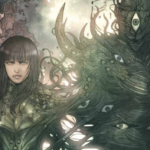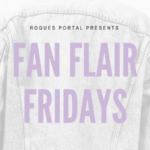
Paper Girls #14
Writer: Brian K. Vaughan
Artist: Cliff Chiang
Letterer: Jared K. Fletcher
Colour Flats: Dee Cunniffe
Publisher: Image Comics
A review by Stephanie Pouliotte. **This review contains some spoilers/speculation**
I had to take a small hiatus from reading Paper Girls after my last review and, in a good way, I’m really glad I did. I burned through issues #12 and #13 so fast I would’ve gone stir crazy waiting for them to drop each month (almost like I am now for issue #15.) Luckily they both revealed a trove hints and puzzle pieces that kept my speculation gears turning, progressing the plot while also tying back to previous issues and proving Vaughan, once again, to be a master of intricate storytelling. I usually try to stay away from spoilers in my reviews, but having just binged on the last three issues, I’m in the mood for some theorizing, and Paper Girls #14 has given me A LOT to think about. I’ll still try to keep it brief, and I won’t spoil the ending!
So Paper Girls #14 starts off with Mac and KJ reuniting with the others after Wari snipes a saber tooth with an impressive bit of archery. Naturally they fill Erin and Tiff in on the pyramid shaped Editrix that KJ touched and how her experience was nearly identical to Tiffany’s in issue #4, except that she saw flashes of her future, instead of her past. Mac interjects with what she thinks is the more important news, which is that they found another time machine. While certainly important, this feels like classic misdirection by Vaughan. It seems pretty obvious the Editrixes (which means female editor) are a strong clue to understanding the physics of time travel in this world. Let’s break down what we know about them so far.
One was “called down” by the leader of the old-timers in issue #4 and Heck refers to it as a Poincaré construct. I got my wiki on and tried to get a fuller picture. Put plainly, if you look at a sphere dead on, you see the boundary of its space as a circle, similarly a sphere is merely a facet of a fourth dimensional construct. The Poincaré conjecture explains this by stating that any closed (no holes), limited object can become a sphere. Shapes have been a recurring motif since Tiffany was first touched by the Editrix, causing her pupils to dilate into squares as the panels hinged off the page and showed her the past. Similarly, KJ touching the tetrahedron Editrix caused her pupils to turn into inverted triangles (identical to Heck and Naldo’s actually) and instead she saw into her future. In Paper Girls #14, the time traveler Qanta Braunstein confirms that KJ’s Poincaré construct does in fact exist in the fourth dimension and is merely “allowing part of itself to be observed” in the third dimension, its tetrahedron face. The relationship between the dimensions could explain how time creates the “folding” tears and how they manage to time travel. If these constructs exist in the fourth dimension, it’s conceivable that touching them allows you to view a different facet of time.
The fact that Qanta says the Poincaré construct is “allowing” them to observe it is quite telling I think. It’s very passive compared to the last Editrix that attacked Tiffany on the orders of the old-timers, who we later find out control a host of them. This one doesn’t attempt to harm them and showed KJ glimpses of future events that included an image of the old-timers’ leader holding Erin hostage with a gun in hand. Speaking of which, Qanta mentions her birthday in this issue as well, and wouldn’t you know it’s November 25, 2016. Add in the facial resemblance and I’m betting she’s the mother of the leader of the old-timers, who offhandedly says his mother was born in 2016 in issue #10. Maybe a red herring, but this seems pretty pointed. So could these premonitions be interpreted as a warning? Perhaps. The information it shows KJ is certainly more useful than the mental torture the last one inflicted on Tiff, and the triangle is the same shape as the pupils of the teenaged chrononauts who saved Erin’s life in the first issues. If it has some form of consciousness, perhaps it sided with the good guys? Though we don’t even know for sure who are the bad guys in all this!
In the opening pages, it’s confirmed that Wari and her son escaped the three men in her guild, who all have a claim at being Jahpo’s father. This was pieced together in the last issue; they seem to believe that all three are the biological father and strongest of the three men is meant to get the child. It’s still unclear why they each have what appears to be media control symbols (square, triangle, power button) painted on their chests, but we know they’ve been collecting artifacts from the future and it feeds into the shape motif. The Editrixthat connects to the past and sides with the old-timers is associated with a square (or stop button) and the other connects to the future and is associated with the triangle (or play button). The Poincaré conjecture all ties back to the 3-sphere, so perhaps the last circular symbol (power button) somehow relates to the present and another construct will be introduced in later issues?
The prehistoric language is tougher to decipher than that of the teenaged chrononauts (check out my decoder in the last review.) Here’s what I could gather from the last three issues, though only the first one is truly confirmed by the text in issue #13.
“Oo cha vera?”: Where is our son?
“Pentago”: Shooting star
“Nee mahrdi Jahpo!”: Stay away from Jahpo or Don’t hurt Jahpo
“Haag.”: Enough
“Zarati H’ay!”: After her!
“Hagat!”: Stop or Don’t
“Cha vera oo.” (variation of the first one): Our son is there.
“Dra baghunee!” appears at the end of the Translation Tryout in the letter pages of issue #13: Good luck!
There’s a lot more text to be translated and I think they’re going to come out with the results of the Translation Tryout in Paper Girls #15. It’s still just a guessing game at this point, but would be interesting to see what others come up with!
This issue isn’t all clues and mysteries, we get some solid character growth too. KJ still hasn’t told anyone about the visions she saw and focuses on dealing with the changes in her life, both physical and emotional, even as Mac continues to point out that she got her period as a demeaning insult. KJ also leads a daring plan to rescue Qanta from the three men, putting her fly new footwear to good use! Even though Qanta is likely a forbearer of the old-timers, she doesn’t seem to be in step with them, or at least not at this point in her timeline. It continues to amaze me that in the five-issue time periods comprising each arc, Vaughan manages to introduce new characters and fill them out, all while keeping this complex set of moving puzzle pieces in mind and revealing it in fragments at just the right time.
Cliff Chiang’s artwork is stellar as always. He deftly captures the motifs of the narrative in his designs, like how the glowing surface of tetrahedron construct is a pattern of circles (as was the surface of the Editrix Tiffany encountered.) Matt Wilson continues with the series’ now signature twilight colouring and creates a stunning effect for the Poincaré construct.
Verdict
Buy it! I was at the edge of my seat by the end of Paper Girls #14 and it still remains my favourite on-going title. It’s a captivating, strange sci-fi mystery that begs to be picked apart and looked at from every angle; too bad I’m stuck looking at things in this dimension.


![[REVIEW] ‘HAMILTON’ IS GUARANTEED TO LEAVE YOU SATISFIED](https://geekd-out.com/wp-content/uploads/2020/07/3A67DC5B-F5F8-474F-B094-A3BC26ABECF3-150x150.jpeg)
